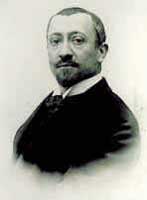پول ڤيار
پول أولريش ڤيار Paul Ulrich Villard | |
|---|---|
 | |
| وُلِدَ | 28 سبتمبر 1860 |
| توفي | 13 يناير 1934 (aged 73) |
| المدرسة الأم | مدرسة المعلمين العليا |
| عـُرِف بـ | أشعة گاما |
پول أولريش ڤيار Paul Ulrich Villard (عاش 28 سبتمبر 1860 - 13 يناير 1934) هو كيميائي وفيزيائي فرنسي. اكتشف أشعة گاما في عام 1900 عندما كان يدرس الأشعة المنبثقة من الراديوم. وقد كان إرنست رذرفورد هو من اقترح اسم "آشعة گاما" لأنها كانت أكثر اختراقاً من كل من آشعة ألفا وآشعة بيتا.
ڤيار تخرج من مدرسة المعلمين العليا في 1881 وعمل في مختبراتها في قسم الكيمياء حتى تقاعده. ينسب إليه اكتشاف هيدرات الأرگون. أمضى الجزء الأول من حياته (1888-1896) في دراسة مركبات مماثلة تحت ضغط عال.
انتخب عضوا في أكاديمية العلوم الفرنسية في 1908.
البحث المبكر
وُلِد ڤيار في سان-جرمان-أو-مون-دور, رون. وقد تخرج من مدرسة المعلمين العليا في 1881 ودرّس في العديد من المدارس الثانوية، منتهياً في ليسيه في مونپلييه. وقد احتفظ بمنصب معملي في مدرسة المعلمين العليا حتى تقاعده. وحين اكتشف ما نسميه الآن أشعة گاما، كان ڤيار يعمل في قسم الكيمياء في مدرسة المعلمين العليا بشارع أولم، پاريس.
Villard is also credited with the discovery of argon hydrate. He spent the early part of his career (1888–1896) focusing on similar compounds at high pressure.
اكتشاف أشعات گاما
تقصى ڤيار الإشعاع من الراديوم salts that escaped from a narrow aperture in a shielded container onto a photographic plate, through a thin layer of lead that was known to stop alpha rays. He was able to show that the remaining radiation consisted of a second and third type of rays. One of those was deflected by a magnetic field (as were the familiar "canal rays") and could be identified with Rutherford's beta rays. The last type was a very penetrating kind of radiation which had not been identified before.
Villard was a modest man and he did not suggest a specific name for the type of radiation he had discovered. In 1903, it was Ernest Rutherford who proposed to call Villard's rays gamma rays because they were far more penetrating than the alpha rays and beta rays which he himself had already differentiated and named (in 1899) on the basis of their respective penetrating powers. The name stuck.
أعماله اللاحقة

Villard spent much time perfecting safer and more accurate methods of radiation dosimetry, which had been done very crudely up until then (typically by evaluating the quality of the image of the experimenter's hand produced on a photographic plate). In 1908, Villard pioneered the use of an ionization chamber for the dosimetry of ionizing radiation. He defined a unit of kerma which was later renamed the roentgen.[1]
التقاعد والوفاة
حين تقاعد ڤيار، غادر پاريس. وقد توفي في بايون، فرنسا، في 13 يناير 1934.
المراجع
- ^ Clarke, R.H.; J. Valentin (2009). "The History of ICRP and the Evolution of its Policies" (PDF). Annals of the ICRP. ICRP Publication 109. 39 (1): 75–110. doi:10.1016/j.icrp.2009.07.009. Retrieved 12 May 2012.